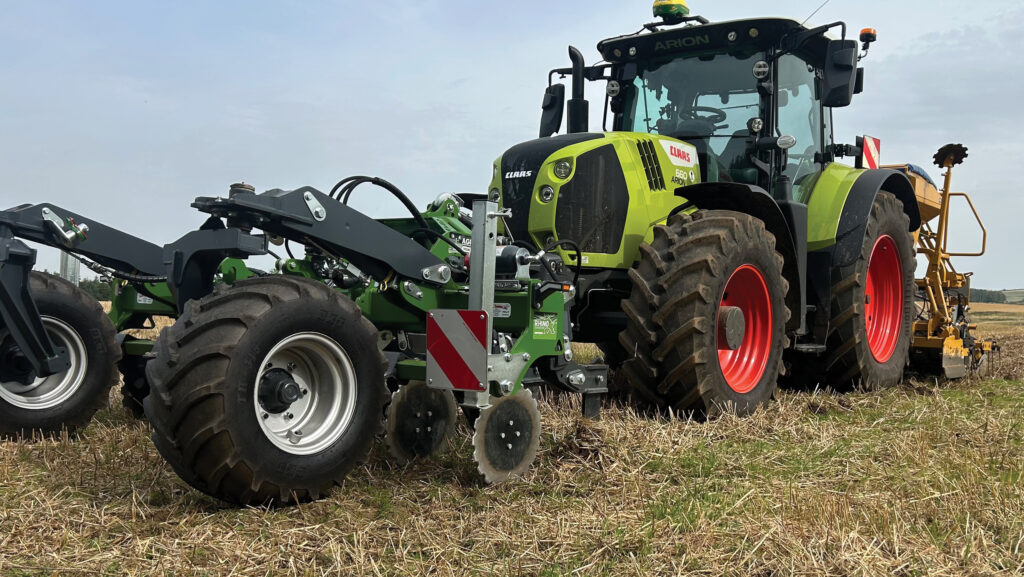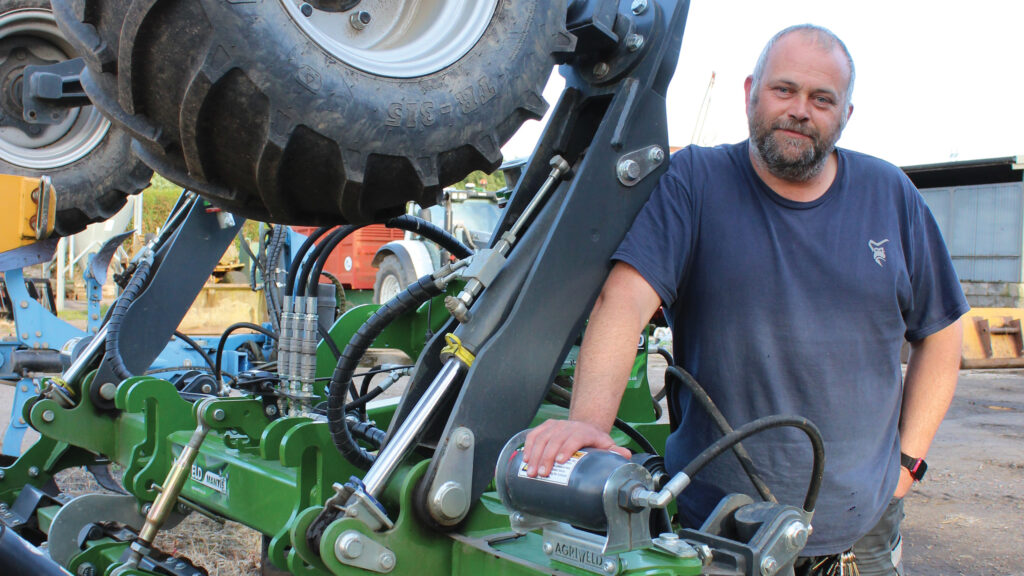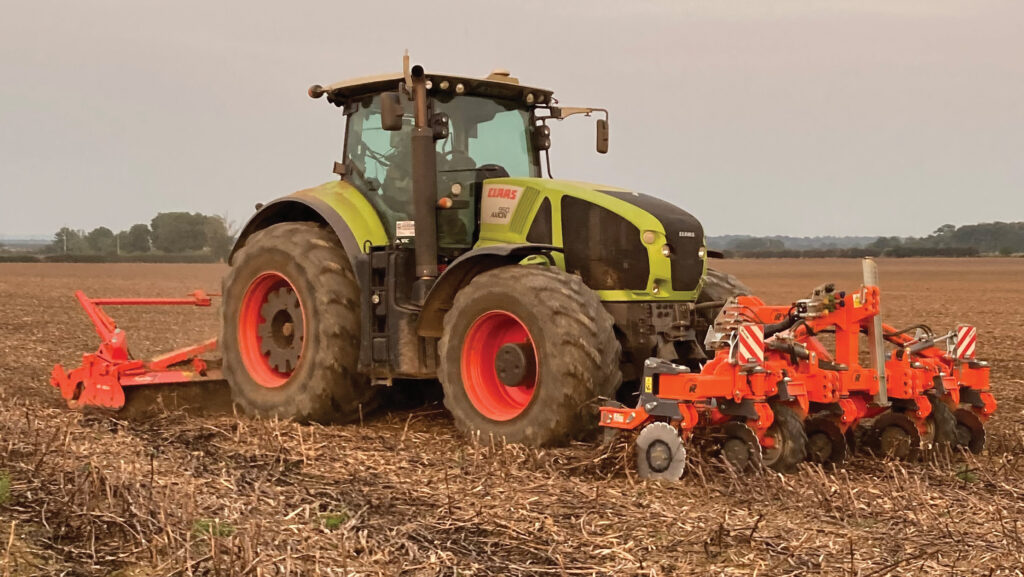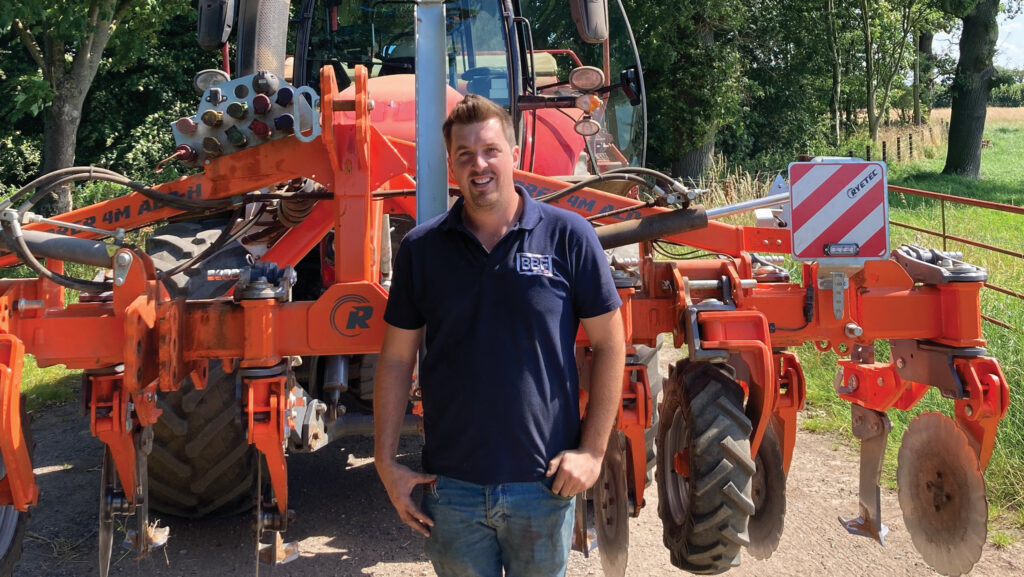Growers opt for front subsoilers to save time and cash
 © Andrew Sommerville
© Andrew Sommerville Saving a pass. It’s a short phrase made up of short words. But it represents the potential to make significant cuts to man-hours, fuel use, and tractor wear and tear by combining two jobs into a single operation.
And that is what has attracted growers to mount a low-disturbance subsoiler on the front of a tractor while operating a seed drill on the back.
See also: Why Lincs contractor Rockscape relies on subsoiling toolbar
It creates a one-pass outfit that benefits soil structure and drainage while completing cultivation and getting the next crop sown, all in one go.
Andrew Sommerville bought his Agriweld Mantis through Ancroft Tractors, primarily for use while drilling oilseed rape on the 140ha of land he farms at Dalkeith, Midlothian.
But he has extended it to the winter wheat plantings as well, operating ahead of a 3m Alpego Jet-X power harrow/air seeder combination on a 185hp Claas Arion 660.
“As it’s just me handling most of the field work here, I’m keen on anything that saves time,” he says. “And if it saves fuel as well, then that has to be good too.”

Andrew Sommerville © Peter Hill
Previous practice was to use a McConnel Shakaerator subsoiler on its own “as and when” to break up compacted ground across soils ranging from pure sand and gravel to heavy clay, and some very stony land that can harbour boulders weighing as much as 2t.
Before the Jet-X was drafted in to get crops established during a very wet autumn, land was prepared by minimum tillage or ploughing, with all drilling handled by a Horsch Pronto disc/packer/disc coulter drill.
“Having been all minimum tillage for a number of years, experiencing the Jet-X made me realise we could reduce the number of passes – and therefore the time involved – during a very busy period,” says Andrew.
“Logically, the next step was to add the subsoiling pass to the combination to compress the workload further. It’s not a fix for every crop and season, so I’ve kept the plough for when it’s just too wet, but it’s a solution that works for me in my situation.”
Initial concerns that mounting the Mantis up front would affect steering control have proved unfounded, largely, Andrew assumes, because of the 5deg leg pivot available in either direction.
It also allows some deflection around big stones, for which Andrew’s machine also has the optional auto-reset leg protection.
Setting the working depth is a “walk in the park”, he says, thanks to the spacers on the hydraulic cylinders that lift the substantial depth wheels.
Fitted ahead of the toolbar, these are effective in work but pose quite a barrier to forward visibility when driving on the road.
“I lift them up to minimise the front overhang when easing out of a field gateway on to the road and then just drop them down enough to see ahead, especially on twisty roads, because you otherwise have some big blind-spots,” Andrew says.
The implement can quickly be re-configured to operate on the back of a tractor thanks to duplicate mounts, but Andrew has not needed to try it that way because it has always been used in combination with the drill.
Agriweld Mantis
- Sizes 3m and 4m rigid, 4m folding
- Discs Serrated 460mm diameter set at 7deg angle to open slot from 5mm to 40mm; rubber flex clamp to toolbar with hydraulic depth adjustment
- Legs 50cm spacing, pivot mounted, fixed length, hydraulic depth adjustment via forward-mounted pivoting land wheels, max depth 300mm
- Leg protection Shear-bolt, triple-use snap bar or hydraulic auto-reset
- Options Drawbar for towing drill, straw rake
- List prices (shear-bolt): 3m £17,995; 4m £poa; 4m folding £poa
Ryetec Restorer

© Josh Swiers
In North Yorkshire, Josh Swiers has used the Ryetec Restorer ALD he bought through Ripon Farm Services last autumn in both front- and rear-mounted configurations with various implements, and will keep experimenting with different setups as time allows.
Farming very light sand to very heavy clay with arable crops and grass for livestock, subsoiling has an important role to play in restructuring compacted soils, breaking through clay layers so rain water can drain into the sand beneath, and taking out deep tramlines.
“We’re used to running a front press so it didn’t seem like too much of a different idea to operate a low-disturbance subsoiler on the front with another implement behind,” says Josh.
“The prospect of saving the time and cost involved in subsoiling separately with our Sumo Trio, or even with the legs on our 3m Quatro disc cultivator, seemed to make sense, and having an implement that could work front or rear and at 3m or 4m depending on soil type, conditions and the second implement, makes it very versatile.”
To date, the Restorer ALD has been operated in front-mounted configuration with a 4m Horsch Express KR power harrow/air drill sowing oilseed rape and grass, with the legs taking out wheelings and compaction.
Similarly, he has used a power harrow on the back to prepare ground in one pass from stubbles before going in with a 4m Vaderstad Rapid after the surface has dried off a bit, and also in rear-mounted form towing the Rapid with the optional hydraulic rear linkage after minimal stubble cultivation.

Josh Swiers © Josh Swiers
Josh says: “I did have concerns about how the steering would cope since we’re running with GPS guidance, but it’s not a problem and the pivoting legs allow you to work in a slight curve where necessary.
“I also get the impression they don’t pull up big stones, presumably because they can pivot round them.”
Converting from front- to rear-mounted takes 10-15 minutes, including fitting the implement linkage, but to go from rear- to front-mounted takes no more than five minutes, so the machine is genuinely versatile in that respect, he adds.
Likewise, he is happy with the pin-and-hole depth adjustment on each Metcalfe leg because they are not too heavy to handle, and having fixed support wheels tucked under the frame keeps the implement compact.
Having plenty of tractor muscle to hand is a key requirement for running combinations in this way, Josh emphasises, especially on the heavy land he farms “that just swallows power”.
Last year, a hired-in 410hp Claas Axion 950 mastered the implement pairings, and this year an MF 8740 of similar power is being given the task.
Ryetec Restorer ALD
- Sizes 3m rigid, 4m/3m folding, 5m/3m folding
- Discs Serrated 450mm or 500mm diameter set straight on pivoting arm, four-position depth adjustment via pivot-mounted land wheels tucked under toolbar
- Legs 50cm spacing, pivot mounted, adjustable length via pin and holes, max depth 300mm or 400mm
- Leg protection Shear-bar or hydraulic auto-reset
- Options Rear hydraulic linkage and towbar, packer roller, hydraulic umbilical system with isobus option
- List prices 3m £20,680; 4m/3m folding £27,610; 5m/3m folding £31,630

